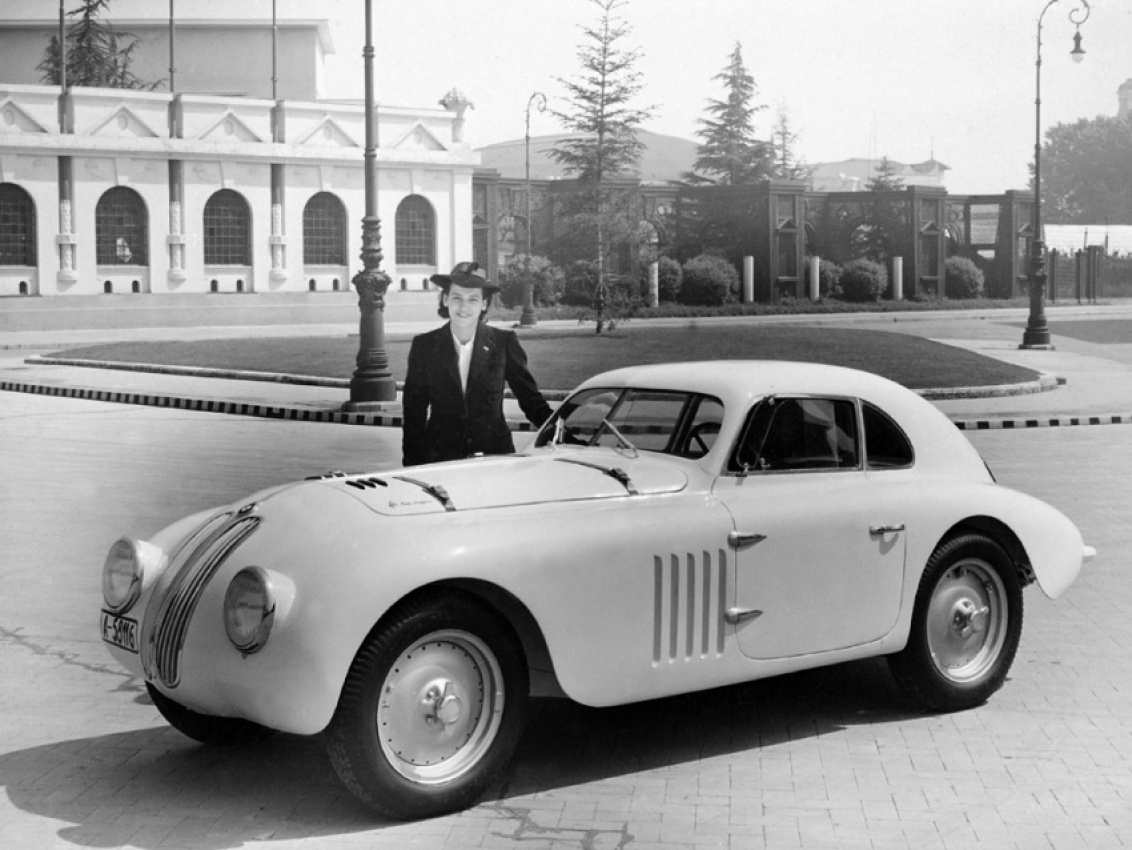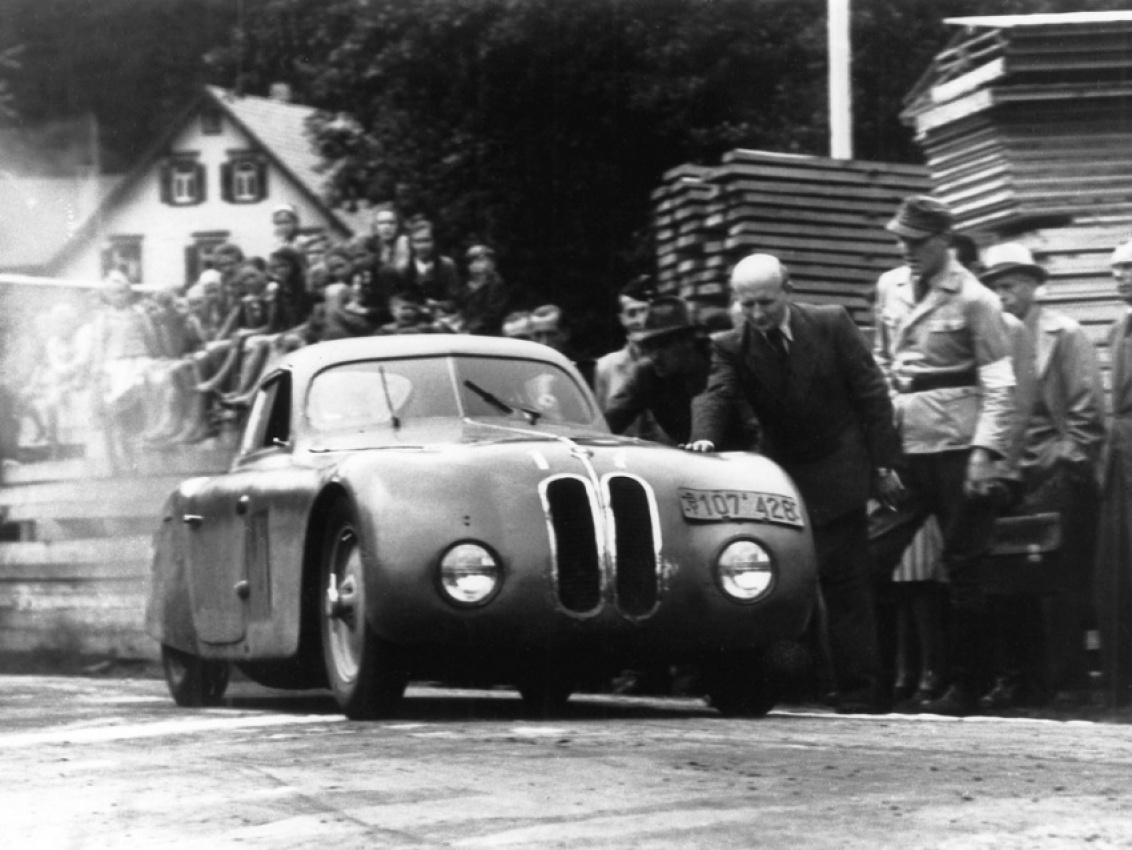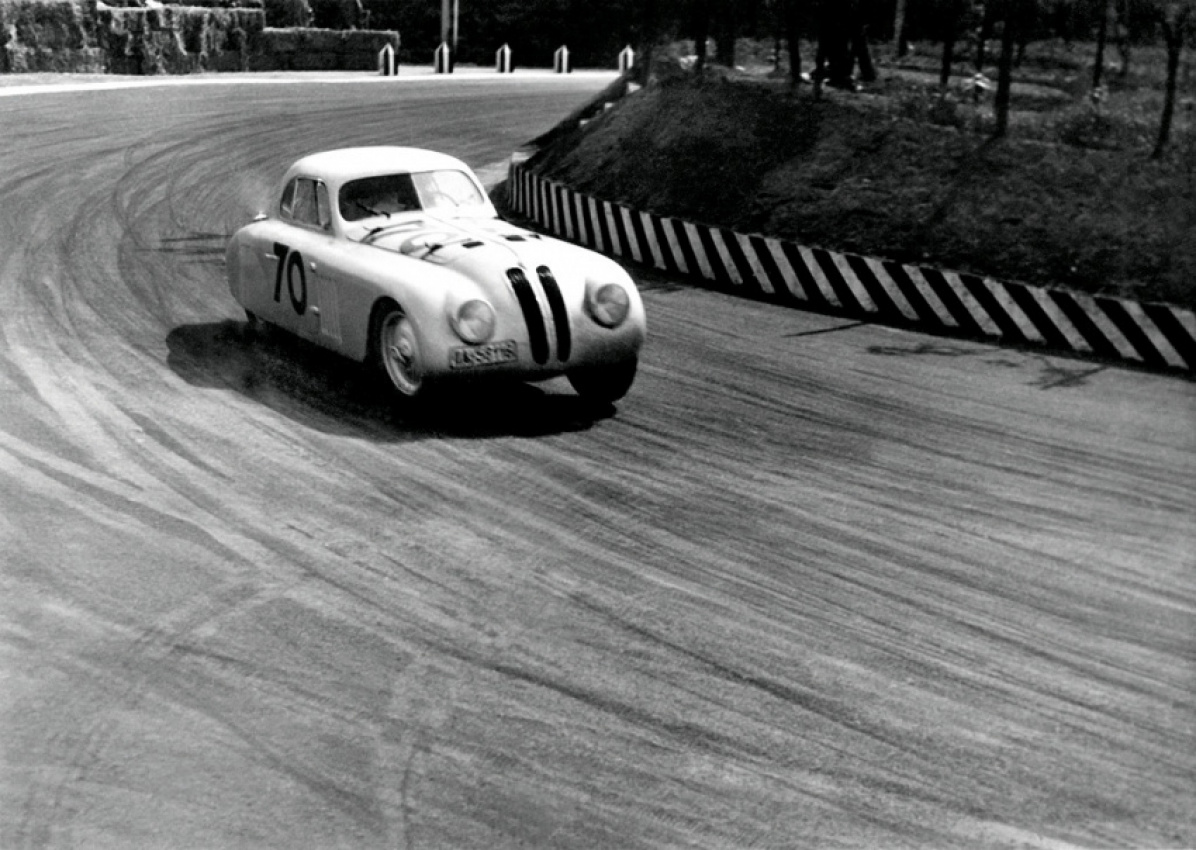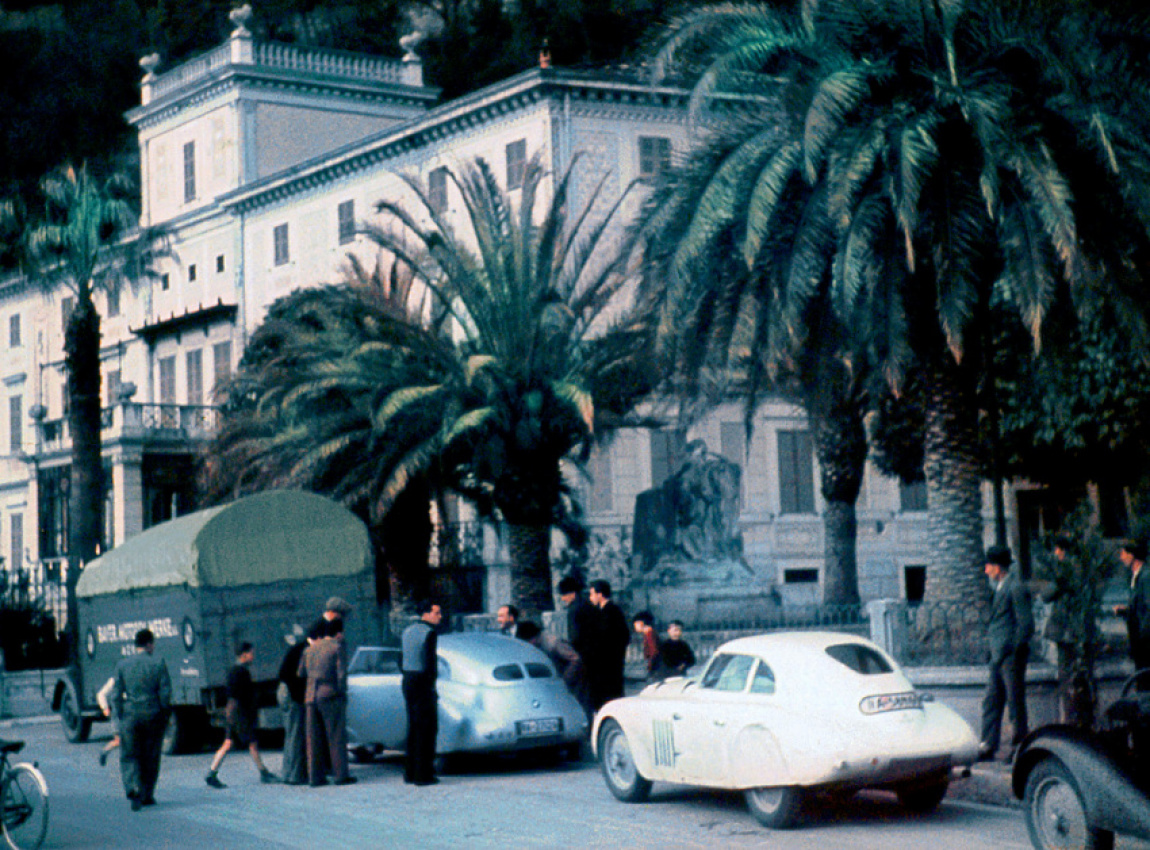In 1938, BMW achieved one of their first international victories by taking a class win at that year’s Mille Milgia. This result was later trumped by an overall victory in 1940 using this one-of coupe 328 Touring Coupe built on chassis 85368.
Being readily available to both amateurs and professionals, the 328 had already become one the leading sports cars by 1940. It participated in most major competitions and won its two litre class almost every time out. Often, the 328 would outclass its larger opposition with smaller and more efficient engineering from designer Fritz Fiedler.
The ultimate race-ready versions of the 328 had tuned engines that would produce 135 bhp and bodies from Touring of Milan who were specialists in aluminum construction. Touring assembled only three cars, two roadsters and a single coupe that lead BMW’s factory team in 1939 and 1940.
These Touring-bodied 328s raced LeMans with good results in 1939 and occupied the leading positions in the 1940 Mille Miglia with Fritz Huschke von Hanstein and his copilot Walter Baumer taking overall victory. They completed the 1000 plus miles at an average speed of 100 mph (160 kph) in the sole Touring Coupe. Their winning car used a thin aluminum skin fixed directly to a load-bearing tubular space frame, giving the coupe a weight of only 780 kg and a top speed of 220 km/h (137 mph).
Shortly after this milestone victory, the Mille Miglia Coupe was lost and until its post-war location was discovered in 1945. Robert Grier then revived the crashed wreck raced it briefly before its long 30 year hibernation in a Connecticut garage. Many considered that one of the most important German race cars had been lost until Jim Proffit found and bought the car in the mid eighties. He finished a comprehensive restoration, raced it briefly then sold the car in 2002 to BMW so it could be included it in their Mobile Tradition collection.
Press Release
70 years ago the racing department at BMW had only one thing on its mind: the 1st Gran Premio Brescia delle Mille Miglia. Five cars from Munich were registered for the big race, but preparations were not exactly worry-free. Indeed, the team ultimately faced a battle to get the cars ready in time. However, as the BMWs crossed the finish line one by one in Brescia on 28 April, they had achieved what few had dared to expect: overall victory, team victory, and third, fifth and sixth place in the rankings. That April day witnessed BMW’s greatest racing success so far on four wheels – and one which continues to define the character of the brand today.
Tests had shown that an enclosed saloon, despite its larger cross-sectional area, could outperform an open sports car using airflow optimisation measures. Convincing performances in the Le Mans 24-hour race in 1937 and 1938 allowed the Frankfurt-based firm Adler, who introduced the first “racing saloons” to competitive action, to demonstrate clearly how streamlined bodies could balance out a deficit in engine power.
BMW had been investigating this area of car development at the same time, but it was Professor Wunibald Kamm, head of the Research Institute of Automotive Engineering and Vehicle Engines at the Technische Hochschule Stuttgart (FKFS), who conducted the first wind tunnel tests with BMW models.
The BMW engineers were now working under considerable pressure. As a celebration of the Berlin-Rome Axis, the German and Italian racing authorities had decided to organise a high-speed race in October 1938 on the newly built motorways between the two capitals of fascism. For BMW and the other manufacturers involved, this meant developing a high-performance sports car in double-quick time, one which could not only hold its own in race competition, but also had a realistic chance of overall victory.
Closed Roof
Rudolf Flemming, who had played a major role in the design of the 328, was instructed to make the car with a closed roof in order to use all the benefits of streamlined design. However, this ruled it out of sports car races in Germany as closed cars were not permitted. Guided squarely by the principles of lightweight design, Flemming designed an intricate space frame for the 328 chassis and covered it in a thin aluminium skin.
However, the car known internally as Project AM 1007 was far from convincing. The Eisenach-built body fell short of the mark in terms of workmanship, and the car’s handling left a great deal to be desired. While the car achieved previously undreamt-of speeds on test runs, it was so unstable that it needed the full width of the motorway to do so. A huge amount of development work was still required to turn this into a racing car worthy of the name.
The efforts of BMW to get a fast car up and running had not gone unnoticed outside the company. Back in the spring of 1938 the NSKK had founded its own racing operation, a self-styled German national team for sports car racing. Its aim was to fly the German flag at events abroad with its own trio of BMW 328 racing cars. The BMW factory had a contractual obligation to keep the NSKK cars up to the latest stage of development, but its new racing saloon represented a potential rival to the NSKK team – one that had to be taken seriously. Under no circumstances could a works driver be allowed to jeopardise the victory the NSKK team had set its sights on. However, when Prince Max zu Schaumburg-Lippe, the team’s leading driver, demanded he also be given a racing saloon, BMW responded that they had no spare capacity to built one.
The Touring Coupé
Schaumburg-Lippe was therefore left with no other option than to shop around among his allies. The Mille Miglia had offered clear evidence that smaller-engined cars could achieve extremely high speeds through the use of lightweight, streamlined bodies. Now, a year later, Germany’s good relations with Italy helped to prompt an offer from Carrozzeria Touring to produce a streamlined body. The Milan-based coachbuilder was already working on a similar project for Alfa Romeo and could call on previous experience for the job, having built a body of the same type a year previously. This streamlined construction in patented superleggera form could be adapted to the standard 328 chassis with no great trouble, and the Italian craftsmen came up with the finished article in just four weeks.
With no wind tunnel testing available at Touring, the engineers successfully relied on instincts and empirical methods to give the car the right form. The Coupé weighed in at just 780 kg and looked resplendent in German racing white, but it was far more than just a pretty face. Test runs had shown that it was capable of exceeding the 200 km/h mark – and holding a relatively straight line in the process. The Touring Coupé lined up for its debut race at Le Mans on 17 June 1939 with Prince Schaumburg and BMW engineer Hans Wencher entrusted with the driving duties. After 24 hours and 3,188 kilometres, the pairing emerged triumphant in the 2-litre class with a sensational average speed of 132.8 km/h. They even managed an outstanding fifth position in the overall classification, getting the better of much larger-engined cars along the way.
1940 Mille Miglia
Spring 1940. In Italy all attentions are focused on bringing the Mille Miglia back to life. The legendary race had last been run over the historic course in 1938. However, after a rash of accidents it had been temporarily suspended. Now, two years later, the Mille Miglia was back in business, but the original route had been dropped in favour of a 167 km triangular course between Brescia, Cremona and Mantua. The drivers would complete nine laps of the new circuit, a move warmly welcomed by the watching pubic, who only saw the cars fly by once when the race followed its original route.
The new route was not as spectacular, though. It followed well-surfaced roads through flat countryside and included a lot of long straight sections which were expected to lead to high average speeds. In a nod to tradition, the race was once again billed the 1st Gran Premio Brescia delle Mille Miglia.
Planning for the German entry got under way with military precision in March 1940. BMW racing boss Ernst Loof travelled to Italy with a group of drivers, the two Coupés and a single Roadster to familiarise themselves with the route, work out a race strategy and organise the building of their garage. Working according to average fuel consumption of 20 litres per 100 km, the course was split into three 500 km sections. On this basis, the ideal location for a garage turned out to be Castiglione, some 25 km outside Brescia. This would be the topping-up point for fuel and oil, and Loof could take the opportunity to pass on any necessary instructions to his drivers here.
n the final three days before the race the drivers gathered with their cars for technical inspection at the Piazza della Vittoria in the centre of Brescia. Among them were the five German BMWs with their silver paintwork. The starting field was dominated in traditional fashion by the red cars of the local contenders. 70 Italian driver teams would line up for the race in FIATs, Lancias and Alfa Romeos. They would be joined by two blue cars from French manufacturer Delage, also with Italian drivers at the wheel.
The members of the NSKK team were entered to drive the three streamlined Roadsters, having represented Germany with great success in races abroad over the previous two years. Car number 71, the first streamlined Roadster, was piloted by Hans Wencher and Rudolf Scholz, the two other Roadsters – car numbers 72 and 74 – were crewed by Willi Briem/Uli Richter and Adolph Brudes/Ralph Roese respectively. The three teams were under instructions not to push too hard, but to maintain a good speed and look after their machinery. Although the aim was to finish as high up the standings as possible, the main priority was to complete the race and win the team prize.
The two Coupés, meanwhile, were entered by the ONS (the highest-ranking national sports authority in Germany at the time). Fritz Huschke von Hanstein and Walter Bäumer would drive the Touring Coupé, while two outstanding Italian drivers – Count Giovanni Lurani Cernuschi and Franco Cortese – had been recruited to pilot the works Kamm Coupé. While the target for these two Coupés was overall victory, tradition suggested that the Alfa Romeo team was a far more likely winner. BMW’s Italian driver pairing were certainly in with a chance, though, the Kamm Coupé having displayed superior handling in testing and reached much higher speeds than the Touring Coupé.
28 April, 4.00 a.m. The cars are sent on their way at one-minute intervals. Von Hanstein/Bäumer – in the first BMW – entered the fray at 6.40 a.m., followed by their team-mates and the Italian drivers in the largest-capacity class. The youngster von Hanstein set out his stall from the off, covering the first lap at a speed nobody present had thought possible. Already, the gap between the BMW driver and his closest pursuer in a Delage was one and a half minutes. Lurani/Cortese, meanwhile, were lying third in the second BMW Coupé, followed by one of the highly fancied Alfa Romeos. The three Roadsters were biding their time in seventh, eighth and ninth positions.
On the second lap the two BMW Coupés led the way, with the Italians locked in a battle with the charging streamlined Roadsters. However, the Kamm Coupé could not keep up such a breakneck pace for long. It was hit by problems first with the carburettor, then with the oil supply, and on lap 7 the hugely disappointed driver pairing were forced to retire from the race.
The Touring Coupé, meanwhile, was continuing to reel off the fast laps undeterred. Indeed, von Hanstein set the fastest time ever recorded in a sports car race with an average speed of 174 km/h. However, there was the odd difference of opinion between von Hanstein and his co-driver Bäumer, as the ambitious baron was determined to win the race and ignored the pre-arranged driver changeover. In the end, Bäumer had to be persuaded to settle for the role of co-driver in order to make sure of the win. The Coupé was gradually building up an unassailable advantage over the chasing pack, though, and the two men finally swapped seats a few kilometres from the finish. In the end, it was Walter Bäumer who had the privilege of driving the Touring Coupé across the line to claim overall victory.
Unsurprisingly, celebrations were decidedly muted among the Italian crowd. Instead, the packed stands were immersed in a collective sense of bewilderment. What had happened to the red cars? Over 15 minutes passed before the Alfa Romeo of Farina/Mambelli came home in second place, followed by Brudes/Roese in third, Biondetti/Stefani in fourth, Briem/Richter in fifth and Wencher/Scholz in sixth place. BMW had topped both the team and overall standings, and great shows of excitement awaited the crew on their return to Munich. Odeonsplatz and the Residenz (Royal Palace) provided an impressive setting in which to display the winning car to the people of Munich.
1939 BMW 328 Mille Miglia Coupé Gallery
See full 1939 BMW 328 Mille Miglia Coupé Gallery here






In Detail
| type | Series Production Car |
| built at | Munich, Germany |
| engine | Inline-6 |
| displacement | 1971 cc / 120.3 in³ |
| bore | 66 mm / 2.6 in |
| stroke | 96 mm / 3.78 in |
| power | 100.7 kw / 135.0 bhp @ 5500 rpm |
| specific output | 68.49 bhp per litre |
| bhp/weight | 173.08 bhp per tonne |
| body / frame | Steel |
| driven wheels | Front Engine / RWD |
| front tires | 5.50 x 16 |
| rear tires | 5.50 x 16 |
| front brakes | Mechanical Drums |
| rear brakes | Mechanical Drums |
| f suspension | Rigid Axle w/Transverse Leaf Spring |
| r suspension | Rigid Axle w/Leaf Springs |
| curb weight | 780 kg / 1720 lbs |
| wheelbase | 2438 mm / 96 in |
| length | 3962 mm / 156 in |
| width | 1514 mm / 59.6 in |
| height | 1097 mm / 43.2 in |
| transmission | 4-Speed Manual |
| top speed | ~220.5 kph / 137 mph |
| designers | Fritz Fiedler |
Keyword: 1939 BMW 328 Mille Miglia Coupé
